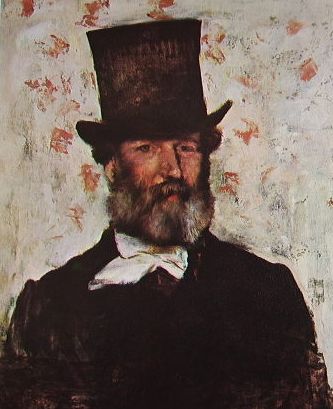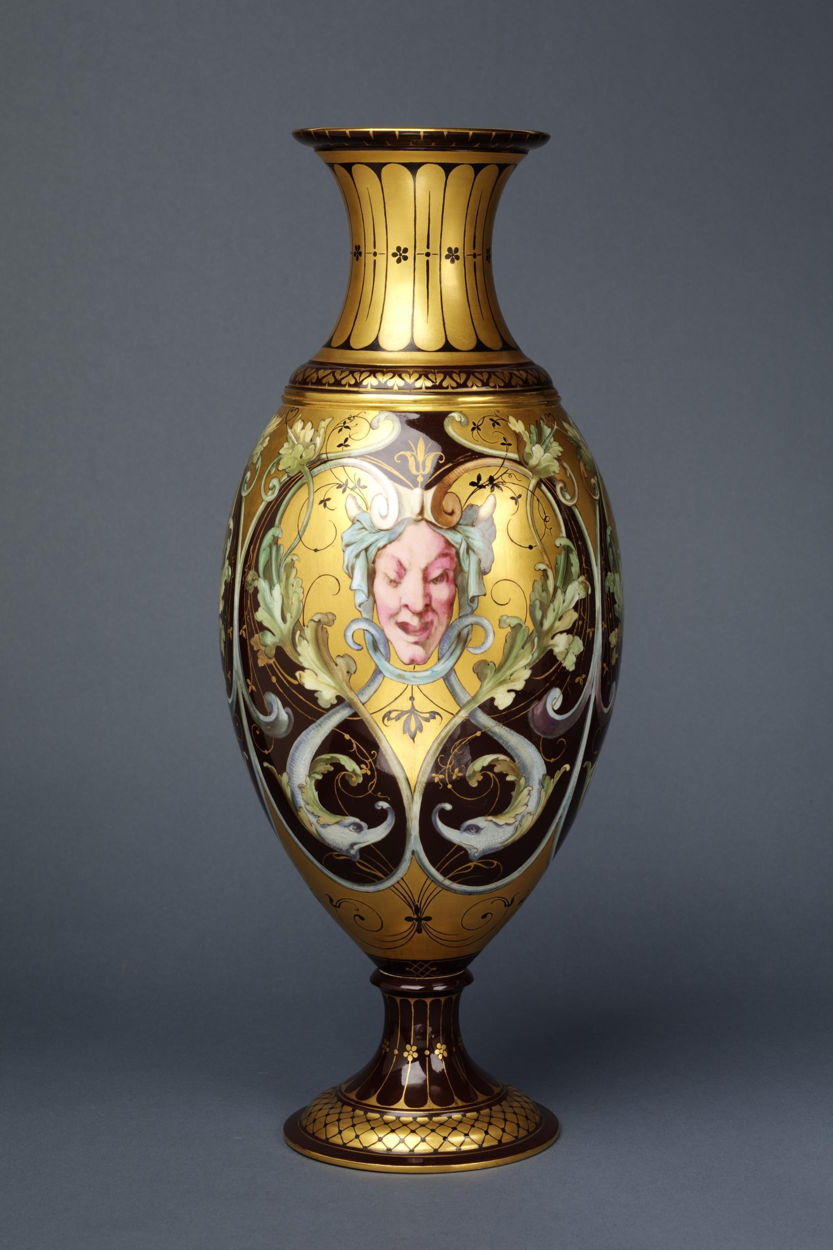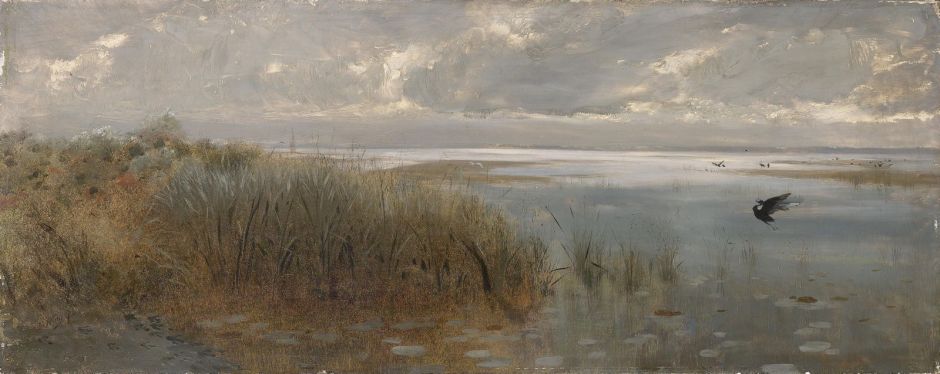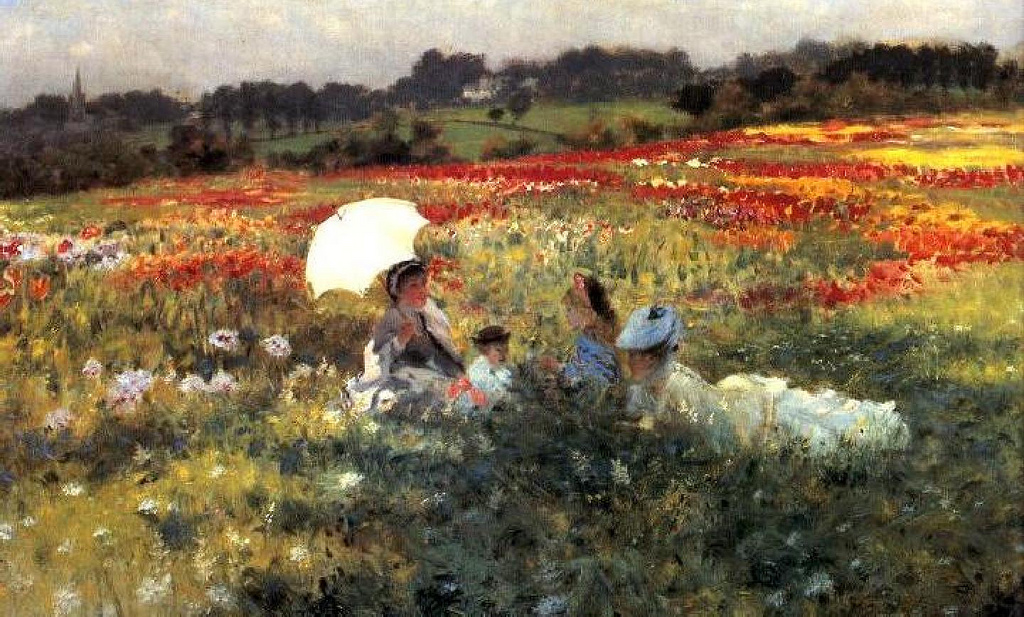(Jean-Baptiste-)Léopold Levert (1828-?)
A friend of Edgar Degas, who painted his portrait, he took part in the Impressionist Exhibitions of 1874, 1876, 1877, and 1880. He is understood to have been a landscape painter in Barbizon style, but I have been unable to locate any electronic images of his work. He was also apparently a designer of military uniforms, and early in his career did some fashion illustration too. He has vanished so completely that I have been unable to discover the year of his death.

Alfred Meyer (1832-1904)
He was a highly accomplished painter in enamel, usually on copper but also on porcelain. He first exhibited in the Salon of 1864, and two years later was awarded a medal for his work shown there. He was an active member of the Impressionist’s company, and following its winding up (after the First Impressionist Exhibition in 1874), he joined with Pissarro and others in establishing an alternative group, l’Union, in August 1875, which was structured as a trades union rather than a company.
As secretary of l’Union, he intrigued against Monet in particular. He was key in organising the group’s first exhibition, which opened on 15 February 1877 at the Grand Hôtel near the Paris Opera. However most of the Impressionist painters who had joined the group withdrew beforehand and did not exhibit there. The exhibition did not attract much attention, and his involvement with Impressionism seems to have faded.
His career in decorative arts developed, and he was appointed Professor at the École Bernard Palissy in Paris, where he rediscovered processes used by the ancient enamelers of the Limousin. He also worked for the Sèvres porcelain factory, the houses of Vever and Falize, as well as independently. He continued to exhibit his work at the Salon.

Auguste de Molins (1821-1890)
Born in Switzerland, he trained with Victor Chavet in Geneva, Alexandre Calame, and Charles Humbert. His work was first accepted for the Salon in 1850, and occasionally thereafter. He painted mainly country genre scenes, including hunting and animals, and landscapes in fairly realist style with some Barbizon school influence. He was well travelled, and published a book about his visit to Indonesia.
Following his involvement with the First Impressionist Exhibition, he returned to Switzerland where he became Professor of Drawing and Painting at Lausanne. A few of his paintings come up for auction, but no images were available for use here, I am afraid.
Émilien Mulot-Durivage (1838-1920)
He was born in Granville, on the Normandy coast in Mont Saint-Michel Bay, and went to Paris, where he became friends with Cézanne, Degas, Monet and Renoir, leading to his showing paintings at the First Impressionist Exhibition. However his work received little attention and remained unsold. He therefore returned to live in Saint-Sauveur-le-Vicomte, on the west coast of the Cherbourg Peninsula, where he became well-known for his landscape paintings of the nearby valley of the Ouve, and of gardens. I have been unable to find images of any surviving paintings of his.
Giuseppe (or Joseph) de Nittis (1846-1884)
He was an Italian, born in Barletta, on the south-east coast. He started studies at the Instituto di Belle Arti in Naples, but was expelled from there in 1863 for ‘insubordination’. He had two paintings accepted for the Neapolitan Promotrice exhibition the following year, which started to establish his name. He met some of the Macchiaioli, and became a close friend of Telemaco Signorini.
He moved to Paris in 1867, where he made a contract with the Goupil gallery to provide genre works. He was accepted at the Salon, but returned to Italy, where he concentrated on painting several views of Vesuvius. In 1872 he returned to Paris, where his painting Che Freddo! (‘Freezing!’) was accepted for the 1874 Salon. That same year his friend Edgar Degas invited him to take part in the First Impressionist Exhibition, where Degas hoped that his growing reputation would show that those in the exhibition were not just failures from the Salon des Refusés.
At the time of the exhibition, de Nittis was in London. Because of pressure on space, one of his five paintings which had been accepted for the Impressionist Exhibition was not hung for several days after it opened. The critic Alexis had already moved several of the Impressionists against de Nittis, describing his work as “less painting than pastry” in 1873. The four views of Naples shown in 1874 were described by one critic as “formless daubs”, which inevitably upset him.
De Nittis did though buy four of Monet’s paintings, and two of Berthe Morisot’s, and came to be liked more as a patron than a fellow artist. He remained committed to a naturalistic style, and in common with the mainstream Impressionists often explored transient effects of light, painted snow scenes, and the reconstruction of Paris. He was also strongly influenced by Japanese style.
He pursued a successful career independently of the Impressionists, with a lively social circle including Telemaco Signorini, Giovanni Boldini and Federico Zandomeneghi. He painted pastel portraits of the famous and fashionable, including De Goncourt, Zola, Manet, and Duranty. He was awarded the Legion of Honour in 1878, and the following year had a successful one-man show organised by the new magazine La Vie Moderne.
In 1882, with art dealer Georges Petit, he co-founded the Exposition Internationale, which brought him further fame. However he died suddenly of a stroke in 1884, at the age of just 38.

I have been unable to find any of the genre scenes for which he was contracted to Goupil, and the earliest work which I can find is his Along the Ofanto (1870), painted when he had returned to Italy. Although it has similarities in style to that of the Macchiaioli, his light is brighter and gives a richness to the landscape.

His portraits, such as A Lady from Naples (1872/79), have some similarities in style with Boldini, although he does not have the same ‘swish’ in his brushstrokes. The contrast between the figure’s flesh and very painterly approach to her clothing is typical of his work, and that of other successful portraitists in the late 1800s.

First Dance (date not known) may come from the same period, but appears to have been a much quicker oil sketch, the model’s flesh not brushed to a portrait finish.

His landscapes, particularly the panoramic Seascape near Naples (1873), consist of a delicate balance between the fine detail of the foliage in the foreground and birds, and a loose, painterly style in water and sky. I fancy that even Boudin would have been proud of this sky.

Che Freddo! (Freezing!) (c 1874) was accepted for the Salon in 1874, and captures the biting cold of a bitter and windy day.

Probably also intended for the Salon, Avenue de Bois du Boulogne (1874) is much less painterly in its approach, and socially more acceptable than the works of the mainstream Impressionists, or Manet.

Although more finely finished than the snow scenes of the Impressionists at the time, his A Winter Landscape (1875) is just as atmospheric.

His paintings of London, including The Victoria Embankment, London (1875), are thoroughly painterly, rich in light, and compare well with any made during the latter half of the 1800s.

Painted during one of his visits to England, In the Fields around London (date not known) is a thoroughly Impressionist motif, accomplished in a thoroughly Impressionist style. Unlike its equivalents by Monet, it is almost unknown.

In Place des Pyramides (1876), de Nittis depicted the extensive building works in Paris at the time, and the bustle of the streets.

His Westminster Bridge, London (1878) is a distinctive essay in steam, form, and light, with the famous silhouette of the tower of Big Ben and the Palace of Westminster in the background, lit by a mackerel sky.

Winter Walk (1879) contrasts the careful finish of the face with the highly gestural snowscape background.

Several of his winter scenes show a woman looking wistfully, if not forlornly, into the distance. At the Lake (1880) is a good example, which begs better explanation.

Snow Scene (1880) is not quite as emotionally charged, and has a background which is brushed in very roughly.

Many of de Nittis’ views are historically significant, such as The Place du Carousel Courtyard and the Tuileries in Ruins (1882). This shows the ruins of the Tuileries Palace – which had been burned by the Communards on 23 May 1871 – shortly before it was demolished.

De Nittis could also paint the most intimate of domestic scenes, as in his Breakfast in the Garden (c 1883). His skill in portraying the reflections from glass, china, and metal here is also impressive, and hardly typical for Impressionism.

He was also a skilled etcher, as shown in this View of London (c 1884), which is enhanced with drypoint.

This undated painting of a Woman on the Beach lacks the looseness and panache of John Singer Sargent’s later oil sketch, but has its own charm.

As with several of the Impressionists, he painted views featuring the novel technologies of the day, as in his undated The Passing of a Train.
Summary
Giuseppe de Nittis’ brief but productive career promised high achievement, and he was already an extremely accomplished independent painter when he died so young. Neither his independence nor his premature death are any excuse for forgetting him.
Of all those whose work was shown at the First Impressionist Exhibition but who have now been forgotten, his appears to be of the most consistently high quality, and most original in its style. Currently the few books about him available new or secondhand are in Italian, and it is time that his distinctive paintings were seen more widely, and his work rediscovered.
Of these ‘vanished’ Impressionists, and even when compared with those who succeeded, he stands out as having the most obvious genius. I will research his life and work more thoroughly, and write again about him in the future.

